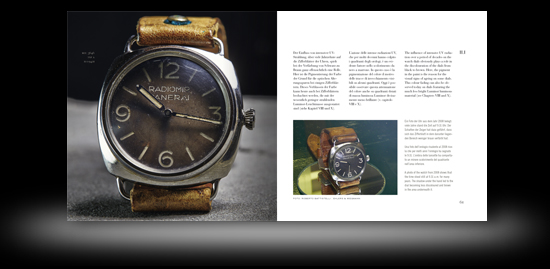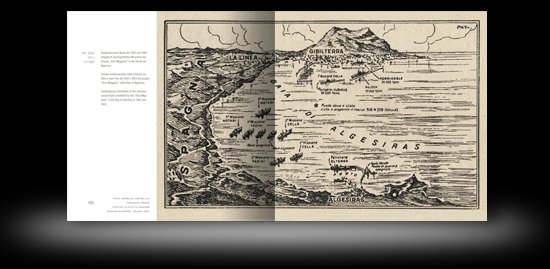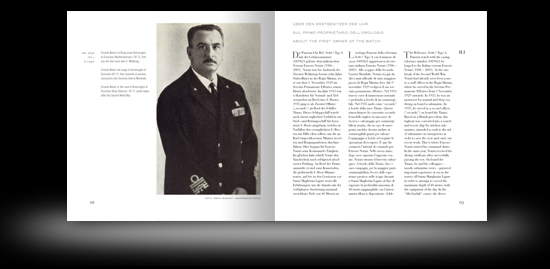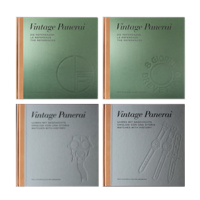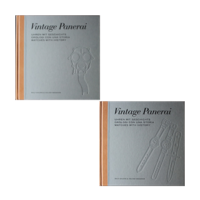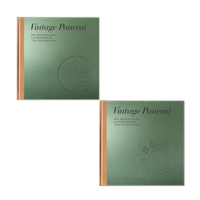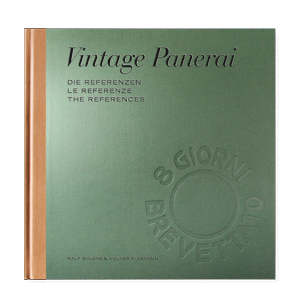Allgemein
Naval heritage – Ernesto Notari’s Radiomir
by Volker on Dec.22, 2025, under Allgemein
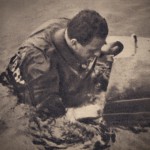 Since 1992, the Vintage Panerai watch which was worn by SLC pilot Ernesto Notari during the Second World War, is on display at the Museo Tecnico Navale in La Spezia. Back then, the watch’s first owner decided to give the watch to the museum on his own wish. It was accepted into the museum’s inventory and since then, it has been on display in a cabinet with other rare items from the Mezzi d’Assalto, where it is resting on one of the last remaining SLC devices.
Since 1992, the Vintage Panerai watch which was worn by SLC pilot Ernesto Notari during the Second World War, is on display at the Museo Tecnico Navale in La Spezia. Back then, the watch’s first owner decided to give the watch to the museum on his own wish. It was accepted into the museum’s inventory and since then, it has been on display in a cabinet with other rare items from the Mezzi d’Assalto, where it is resting on one of the last remaining SLC devices.
In its unaltered original condition, it was an important source of information for us. With the support of the museum we were able to enter all details of the watch into our database. Beside the importance by the history behind, this watch marks the earliest known 3646 / Type A and so became the first watch in chapter II. With its engraved caseback it is of enormous significance with regard to the history of the Mezzi d’Assalto of the Royal Italian Navy.
Page 60 – 61: Comparing photos of Ernesto Notari’s Ref. 3646 / Type A from 2014 and 2008.
Being a member of the Mezzi Subacquei, Ernesto Notari trained at Bocca di Serchio, the secret base of the underwater special unit in Tuscany. In early 1940, the first training exercises were carried out, resulting in the 1935 concept of Teseo Tesei and Elios Toschi evolving into a real, secret weapon. After the desaster of Malta in July 1941, Ernesto Notari was commander of the training base Bocca di Serchio.
In 1943 Notari posted to the secret base in the Bay of Algeciras, the Olterra. After the successful return from mission B.G.6 in May 1943, Notari was awarded with the M.A.V.M. (silver medal for galantry at war) in the rank of Capitano di Corvetta. He solved another successful mission in August 1943: B.G.7, for which he was awarded M.A.V.M. one more time. B.G.7 was the last mission carried out from the tanker Olterra. The declaration of the ceasefire by Italy on 8 September 1943 brought all further plans to an end. The secret of the Olterra was only discovered by the British in October 1943. The undercover missions of the Decima MAS in Gibraltar were therefore highly successful. Although they did not have any major successes like in Alexandria, the continued presence of the Decima for a period of almost three years exercised constant pressure on the British. The use of Villa Carmela and the Olterra as secret starting bases for night-time missions showed the decisiveness of the Decima MAS and its courageous men – one of whom was Ernesto Notari.
Page 150 – 151: Illustration of the missions completed by the “Orsa Maggiore” in the Bay of Algeciras in 1942 and 1943.
After the Second World War, Ernesto Notari continued his career with the Marina Militare. As a Capitano di Fregata, he commanded the reformed special unit from 10 October 1947 to 25 September 1948. As a Capitano di Vascello, Notari served his second captaincy from 1 October 1950 to 14 March 1951. In 1952, he assumed command of the Sezione Tecnica Autonoma in Bacoli. The secret base in the province of Naples existed from 1949 to 1957 before being moved to Varignano as part of a restructuring process . This site was home to some of the remaining Mezzi d’Assalto equipment. By the end of his Navy career, Ernesto Notari had reached the rank of Vice-Admiral (Ammiraglio di Squadra).
Page 92 – 93: About the first owner of the watch, Admiral Ernesto Notari, photo taken after the Second World War.
The watch of Ernesto Notari (a Ref. 3646 / Type A with „Radiomir Panerai“ dial) and the history behind can be read in the book “The References” 1930’s-1940’s (chapter II.I, page 58 to 153). Read more on the Olterra here. Enjoy reading!
Inventors, pilots and a royal visitor…
by Volker on Dec.21, 2025, under Allgemein
The first watches for the pilots of the “new weapon” SLC were delivered in the middle of the 1930’s by Guido Panerai & Figlio to the Commando del 1° Gruppo Sommergibili of the Royal Italian Navy. According to the timeline of the development of the top secret slow running torpedos (siluro a lenta corsa, short: SLC) by the inventors Teseo Tesei and Elios Toschi, waterproof and luminous instruments for the pilots were necessary to carry out proper exercises and to control the SLC in depth and darkness.
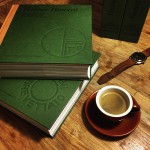 The chapters I and II, dedicated to the first watches for underwater use (Ref. 2533 and 3646) take the readers of our book “The References” 1930’s-1940’s into these early years. Teseo Tesei and Elios Toschi’s ideas became real. But strategic decisions after the Italo-Ethiopian War stopped the secret SLC project. The tests with these small weapons were archived and the Royal Italian Navy focused their interest in huge battleships, cruisers and destroyers.
The chapters I and II, dedicated to the first watches for underwater use (Ref. 2533 and 3646) take the readers of our book “The References” 1930’s-1940’s into these early years. Teseo Tesei and Elios Toschi’s ideas became real. But strategic decisions after the Italo-Ethiopian War stopped the secret SLC project. The tests with these small weapons were archived and the Royal Italian Navy focused their interest in huge battleships, cruisers and destroyers.
The SLC project was re-started by the 1st Flottiglia MAS in 1939 at the advent of the Second World War. With the first missions of the Mezzi d’Assalto carried out from August 1940 onwards, the demand for skilled operators as well as new equipment – and more instruments for the operators – grew fast. An early Ref. 3646 / Type A, dated to April 1940, is featured in chapter II.I followed by the timeline of the missions carried out by the operators of the Decima Flottiglia MAS, the special commandos of the Royal Italian Navy.
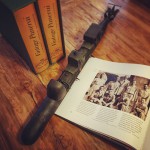 The photo shows page 96 of “The References” with a historic photo from June 1940: The two inventors of the SLC, Teseo Tesei and Elios Toschi, Alberto Franzini and Gino Birindelli above their co-pilots stand together with a royal visitor: Principe Aimone di Savoia Aosta, Duca di Spoleto – just a few weeks before the first missions of the new weapon SLC were about to write naval history.
The photo shows page 96 of “The References” with a historic photo from June 1940: The two inventors of the SLC, Teseo Tesei and Elios Toschi, Alberto Franzini and Gino Birindelli above their co-pilots stand together with a royal visitor: Principe Aimone di Savoia Aosta, Duca di Spoleto – just a few weeks before the first missions of the new weapon SLC were about to write naval history.
Read more about “The birth of a legend – the first Panerai watches (1935-1939)” in chapter I, followed by the timeline of the missions during the Second World War in chapter II.I – more information on the historic content in our “The References” book set with a total of 1392 pages can be found here. Read about the featured watches from Guido Panerai & Figlio in the first and second volume here.
18 December 1941 – today in history…
by Volker on Dec.18, 2025, under Allgemein
After the failed missions in August and September 1940, the Decima MAS returned to the eastern Mediterranean in order to make another attemp to attack the Harbour of Alexandria with SLC devices of the Mezzi d’Assalto: “Operazione G.A.3”, carried out by Tenente di Vascello Luigi Durand de la Penne and Capo Palombaro I Emilio Bianchi (SLC 221), Capitano Genio Navale Antonio Marceglia and Sottocapo Palombaro Spartaco Schergat (SLC 222), Capitano Armi Navale Vincenzo Martellotta and Sottocapo Palombaro Mario Marino (SLC 223).
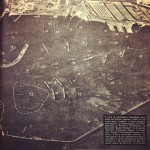 What turned out to be one of the most famous SLC missions in the Second World War has been announced in the Italian War Bulletin N. 585 of the 8th of January 1942: “On the night of the 18th December assault craft of the Italian Royal Navy entered the Harbour of Alexandria and attacked two British battleships anchored there. It has only just been confirmed that a battleship of the Valiant class was seriously damaged and put into dock for repairs, and is still there.”
What turned out to be one of the most famous SLC missions in the Second World War has been announced in the Italian War Bulletin N. 585 of the 8th of January 1942: “On the night of the 18th December assault craft of the Italian Royal Navy entered the Harbour of Alexandria and attacked two British battleships anchored there. It has only just been confirmed that a battleship of the Valiant class was seriously damaged and put into dock for repairs, and is still there.”
Bulletin N. 586 of the 9th of January 1942, added the following: “In the Operation conducted by assault craft fo the Royal Italian Navy in the Harbour of Alexandria and reported in yesterday’s Bulletin we now have definite further intelligence that, in Addition to the Valiant, a second battleship of the Barham class was also damaged.”
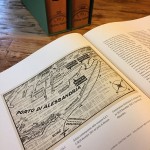 Winston Churchill announced in a speech before a secret session of the House of Commons on the 23rd of April 1942: “A further sinister stroke was to come. On the early morning of December 19 half a dozen Italians in unusual diving suits were captured floundering about in the Harbour of Alexandria… Four hours later explosions occurred in the bottoms of the Valiant and the Queen Elizabeth, produced by limpet bombs fixed with extra-ordinary courage and ingenuity, the effect which was to blow large holes in the bottoms of both ships and to flood several compartments, thus putting them both out of Actions for many months…”
Winston Churchill announced in a speech before a secret session of the House of Commons on the 23rd of April 1942: “A further sinister stroke was to come. On the early morning of December 19 half a dozen Italians in unusual diving suits were captured floundering about in the Harbour of Alexandria… Four hours later explosions occurred in the bottoms of the Valiant and the Queen Elizabeth, produced by limpet bombs fixed with extra-ordinary courage and ingenuity, the effect which was to blow large holes in the bottoms of both ships and to flood several compartments, thus putting them both out of Actions for many months…”
Read chapter II.I of our book “The References” 1930’s-1940’s to find out what happened on 18 December 1941 (page 118-125). More on the historic content in our “The References” book set with a total of 1392 pages can be found here and here. You can purchase “The References” 1930’s-1940’s in our bookstore. Enjoy reading!
18 November 1944 – today in history…
by Volker on Nov.18, 2025, under Allgemein
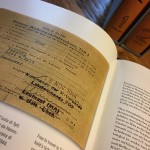 Read chapter VII of our book “History2” to find out what happened on 18 November 1944. Rare documents helped us to capture the history behind a Ref. 3646 / Type D “Kampfschwimmer” watch, which can be found in this chapter.
Read chapter VII of our book “History2” to find out what happened on 18 November 1944. Rare documents helped us to capture the history behind a Ref. 3646 / Type D “Kampfschwimmer” watch, which can be found in this chapter.
Beside photos from the years 1944 and 1945 showing the watch on the frogman’s wrist, as well as his identification papers and travel documents issued in Venice (see photo), helped us to reconstruct the route Hanns-Martin Kaufhold took to the mission grounds in the last months of the Second World War.
Read more about chapter VII of “History2” (70 pages, 58 photos, 6 technical illustrations) here. and here. You can purchase your copy of “History2” in our bookstore.
The Radiomir which returned from Gibraltar to Italy…
by Volker on Nov.09, 2025, under Allgemein
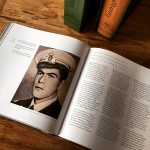 …but alone – without the SLC pilot who used it on his wrist during the mission B.G.5 in December 1942: Licio Visintini.
…but alone – without the SLC pilot who used it on his wrist during the mission B.G.5 in December 1942: Licio Visintini.
Born 1915 and enterred the Royal Italian Navy in 1933, Licio Visintini took part in several missions against the allied fleet in Gibraltar as a member of the Decima MAS. In 1941 Visintini was promoted to Tenente di Vascello. After surviving from SLC missions B.G.3 (May 1941) and B.G.4 (September 1941), carried out by the transport submersible “Scirè” under the command of Junio Valerio Borghese, Visintini returned to Gibraltar undercover in June 1942 where he built the core of the “Orsa Maggiore” on board the tanker Olterra – the hidden base for the SLC units in the bay of Gibraltar.
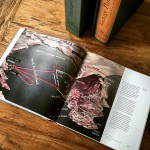 According to legend, Visintini’s „Radiomir Panerai“ was returned to his mother after the end of the Second World War by his former enemy, Lieutenant „Buster“ Crabb (head of the Underwater Working Party in Gibraltar). The return of personal items to relatives showed a great respect that the combatants on different sides had for one another. Crabb, who was himself an experienced diver serving the British Navy, knew from experience all too wellt he level of courage and determination that was neccessary to carry out missions of this kind. Before Visintini’s mother died, she gave the watch to Vittorio Stradi, her son’s best friend. Vittorio Stradi was a „Gamma“ frogman in the Second World War. Fourty years later he passed the watch to his friend Isidoro Mario Nardin, who was also a member of the „Gamma“ frogmen during the Second World War.
According to legend, Visintini’s „Radiomir Panerai“ was returned to his mother after the end of the Second World War by his former enemy, Lieutenant „Buster“ Crabb (head of the Underwater Working Party in Gibraltar). The return of personal items to relatives showed a great respect that the combatants on different sides had for one another. Crabb, who was himself an experienced diver serving the British Navy, knew from experience all too wellt he level of courage and determination that was neccessary to carry out missions of this kind. Before Visintini’s mother died, she gave the watch to Vittorio Stradi, her son’s best friend. Vittorio Stradi was a „Gamma“ frogman in the Second World War. Fourty years later he passed the watch to his friend Isidoro Mario Nardin, who was also a member of the „Gamma“ frogmen during the Second World War.
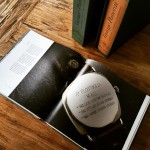 To commemorate the order of ownership, the three names were inscribed for posterity on the caseback, as shown on page 358-359 and 360. For Isidoro Mario Nardin, Licio Visintini’s Panerai watch became a symbol of cameraderie and a memento of his fallen comrade.
To commemorate the order of ownership, the three names were inscribed for posterity on the caseback, as shown on page 358-359 and 360. For Isidoro Mario Nardin, Licio Visintini’s Panerai watch became a symbol of cameraderie and a memento of his fallen comrade.
Chapter II.III in our book “The References” (first volume / 1930’s-1940’s) features the story behind this Ref. 3646 / Type C „Radiomir Panerai“ and its three owners, Licio Visintini (M.O.V.M.), Vittorio Stradi and Isidoro Mario Nardin, on page 350-397.
Information on “The References” 1930’s-1940’s (first volume) can be found here.
Enjoy reading!
[Ralf Ehlers & Volker Wiegmann]
30 September 1940 – today in history…
by Volker on Sep.30, 2025, under Allgemein
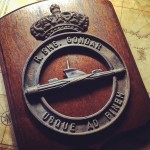 The afternoon of 30 September 1940 marks the end of the mission „Operazione G.A.2“. Just five weeks after the sinking of the Iride, the Gondar (photo: historic crest of the submarine, showing SLC containers on its deck) was the second transport submarine of the Mezzi d’Assalto to be sunk.
The afternoon of 30 September 1940 marks the end of the mission „Operazione G.A.2“. Just five weeks after the sinking of the Iride, the Gondar (photo: historic crest of the submarine, showing SLC containers on its deck) was the second transport submarine of the Mezzi d’Assalto to be sunk.
The submarine Gondar (built in 1937) under the command of Tenente di Vascello Francesco Brunetti was dispatched from La Spezia with Alexandria as her target. On board the Gondar was the officer-in-charge of mission G.A.2, Mario Giorgini, three SLC teams and a reserve team.
When the Gondar reached the target area on 29 September 1940, she received a sobering radio message from reconnaissance: The British fleet had left the Port of Alexandria – so mission G.A.2 was aborted. The Gondar headed now for Tobruk and was already on its return journey when it was discovered by the Australian destroyer, HMAS Stuart. A second destroyer, HMS Diamond and a corvette now tracked the Gondar throughout the night alongside HMAS Stuart.
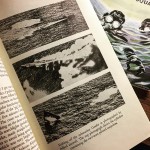 After hours of attempting to evade capture, the Gondar gave up in the early hours of 30 September 1940. Commander Brunetti gave the order to dive down and abandon the Gondar, which effectively saved his team and the SLC pilots from going down after being sunk by the mighty enemy. A British Sunderland flying boat bombarded the Gondar while the crew was already in the water – effectively sealing the fate of the second transport submersible for SLCs (see historic photos on the left). For one of the two inventors of the new weapon, Elios Toschi, this second journey was also to be his last. He was taken prisoner by the British alongside the crew of the Gondar and his comrades – “missione fallita”.
After hours of attempting to evade capture, the Gondar gave up in the early hours of 30 September 1940. Commander Brunetti gave the order to dive down and abandon the Gondar, which effectively saved his team and the SLC pilots from going down after being sunk by the mighty enemy. A British Sunderland flying boat bombarded the Gondar while the crew was already in the water – effectively sealing the fate of the second transport submersible for SLCs (see historic photos on the left). For one of the two inventors of the new weapon, Elios Toschi, this second journey was also to be his last. He was taken prisoner by the British alongside the crew of the Gondar and his comrades – “missione fallita”.
The launch of the new weapon appeared to be ill-fated: Two operations (G.A.1 and G.A.2) failed, two valuable transport submersibles had been sunk and four SLC teams and their officers-in-charge had been taken as prisoners of war. It was to take over a year until another attempt could be made to penetrate the Port of Alexandria in December 1941…
Read more about “The birth of a legend – the first Panerai watches (1935-1939)” in chapter I on page 34-39, followed by the timeline of the missions during the Second World War in chapter II.I on page 106-109. Mario Giorgini, officer-in-charge of the mission G.A.2 is also featured in the second volume of “The References” on page 1016-1022. The Gondar is also featured in our book “History1” in chapter IV on page 288-357.
“Il cavallo di Troia” – the secret SLC base
by Volker on Sep.09, 2025, under Allgemein
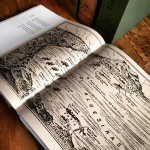 Enemy ships in the harbour of Gibraltar have been in the sight of the Royal Italian Navy since September 1940. After several attacks by “Gamma” frogmen and SLC units, ideas to build a secret base of the Decima MAS were realized in the second half of the year 1942. Convoy ships for the United States were beginning to arrive in quantity. The numbers of potential targets at anchor in the Bay of Algeciras were growing almost daily.
Enemy ships in the harbour of Gibraltar have been in the sight of the Royal Italian Navy since September 1940. After several attacks by “Gamma” frogmen and SLC units, ideas to build a secret base of the Decima MAS were realized in the second half of the year 1942. Convoy ships for the United States were beginning to arrive in quantity. The numbers of potential targets at anchor in the Bay of Algeciras were growing almost daily.
Earlier in 1942, a base for the Decima MAS “Gamma” frogmen was established in the Villa Carmela near La Linea from where several missions were carried out against British merchant ships (see page 126-131 / chapter II.I). During the months of shaping Villa Carmela into an advanced base, the idea for a bigger and much more effective operation had taken form in the mind of Licio Visintini, one of the SLC pilots of the mission B.G.4 in September 1941 (see page 374-381 / chapter II.III) which was carried out from the submarine Scirè.
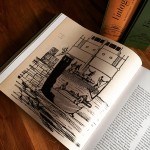 Before the new base was ready for action, each attack at Gibraltar had required a long submarine voyage, air and land transportation of the attack-teams, the shipping of supplies and weapons, arrangements for rendezvous, an approach by submarine, and finally the task of smuggling the survivors back to Italy thru neutral Spanish territory.
Before the new base was ready for action, each attack at Gibraltar had required a long submarine voyage, air and land transportation of the attack-teams, the shipping of supplies and weapons, arrangements for rendezvous, an approach by submarine, and finally the task of smuggling the survivors back to Italy thru neutral Spanish territory.
Licio Visintini’s idea became real with turning the anchored ship Olterra inside the pier of Algeciras into a secret base for SLC missions. Visintini and further technical specialists replaced the original crew of the Olterra. An assembly workshop for the SLC devices (which arrived in sections, declared as spare parts for the damaged ship) was established in the hull. A portside cabin of the Olterra became the observation post with an excellent view of Gibraltar harbour. Finally, a folding door on the port side bow (see coffee table shot of page 386-387 /chapter II.III) became the exit door for the SLC units below waterline to reach their targets – and to return back into the hull of the Olterra. After months of intensive work in total secrecy, the inconspicious ship Olterra was turned into a Trojan Horse – “il cavallo di Troia” – and six men were ready for action with their SLC devices.
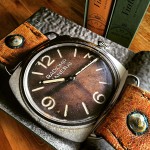 The Olterra was starting point of the following SLC missions against enemy ships in the bay of Algeciras / Gibraltar harbour: B.G.5 (7/8 December 1942), B.G.6 (7/8 May 1943) and B.G.7 (3/4 August 1943). Our book “The References” 1930’s-1940’s features two Ref. 3646 watches which were used during these missions.
The Olterra was starting point of the following SLC missions against enemy ships in the bay of Algeciras / Gibraltar harbour: B.G.5 (7/8 December 1942), B.G.6 (7/8 May 1943) and B.G.7 (3/4 August 1943). Our book “The References” 1930’s-1940’s features two Ref. 3646 watches which were used during these missions.
The Ref. 3646 / Type A “Radiomir Panerai” watch of Ernesto Notari is featured in chapter II.I (page 58-91 / see coffee table shot on the left) – more on this watch and its history can be found here. The Ref. 3646 / Type C “Radiomir Panerai” watch of Licio Visintini is featured in chapter II.III (page 350-367) – more on this watch and the history behind can be found here. The new “The References” books can be ordered only in our bookstore.
Enjoy reading!
[Ralf Ehlers & Volker Wiegmann]
21 August 1940 – today in history…
by Volker on Aug.21, 2025, under Allgemein
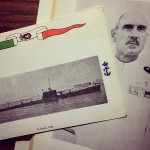 Gulf of Bomba (Lybia). In August 1940, the time had finally come to put the new SLC weapon to the test. Alexandria in the eastern Mediterranean was the main base of the British Mediterranean fleet. The battleships at anchor there were the first targets for missions of the Mezzi d’Assalto involving the SLCs.
Gulf of Bomba (Lybia). In August 1940, the time had finally come to put the new SLC weapon to the test. Alexandria in the eastern Mediterranean was the main base of the British Mediterranean fleet. The battleships at anchor there were the first targets for missions of the Mezzi d’Assalto involving the SLCs.
The transport submersible Iride, under the command of Tenente di Vascello Francesco Brunetti, prepared for its tour of duty with the SLCs on 21 August 1940, ready to attack the Port of Alexandria in the night of 25/26 August 1940. Eleven servicemen with four SLCs aboard the torpedo boat Calipso were dispatched to the Gulf of Bomba on the Libyan coast. There, the SLCs were tested at held ready for departure until they were ready to launch mission G.A.1 a few days later with the submersible Iride.
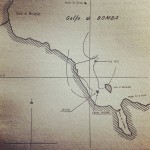 Right at the start of its test run, however, the submersible Iride was spotted by three Fairey Swordfish torpedo bombers, which had launched from the aircraft carrier HMS Eagle. The enemy bombers began their attack straight away (see historic map on the left).
Right at the start of its test run, however, the submersible Iride was spotted by three Fairey Swordfish torpedo bombers, which had launched from the aircraft carrier HMS Eagle. The enemy bombers began their attack straight away (see historic map on the left).
The shallow water in the Gulf of Bomba prevented the Iride from descending quickly. Instead, it attempted to ward off the attack at full speed with its anti-aircraft cannons. At the same time, Brunetti tried in vain to direct the bow of the submersible towards the attackers in order to reduce the area of the Iride exposed to attack. However, the Iride was soon hit by a torpedo and sank. The boats quickly dispatched to the scene managed to rescue some of the shipwrecked crew members from the Iride. A dramatic race against time began.
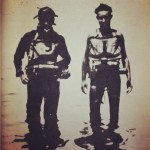 The SLC teams under Gino Birindelli (right in the photo), Teseo Tesei, Elios Toschi, Luigi Durand de la Penne and Emilio Bianchi dived straight down to the wreck of the Iride in order to save the survivors who were trapped down there. Although the equipment belonging to the SLC pilots on board the Iride was lost, but the three SLCs were recovered for use in later missions. The SLCs pilots returned to the Bocca di Serchio on board the Calipso.
The SLC teams under Gino Birindelli (right in the photo), Teseo Tesei, Elios Toschi, Luigi Durand de la Penne and Emilio Bianchi dived straight down to the wreck of the Iride in order to save the survivors who were trapped down there. Although the equipment belonging to the SLC pilots on board the Iride was lost, but the three SLCs were recovered for use in later missions. The SLCs pilots returned to the Bocca di Serchio on board the Calipso.
During the rescue of the survivors from the Iride, they had pushed themselves to the very limit of what was humanly possible. Loss of human life and equipment was the sobering result of the first mission „Operazione G.A.1“ with the new weapon of the Mezzi d’Assalto.
Read more on Gino Birindelli, one of the surviving SLC teams, in chapter VIII.II on page 1014-1043 or click also here. More information on the historic content in our “The References” book set can be found here. Read about the featured watches from Guido Panerai & Figlio in the first and second volume here.
“Operazione Stella” – Luigi Ferraro’s Panerai watch
by Volker on Aug.08, 2025, under Allgemein
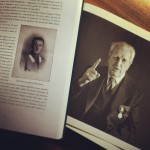 A “Gamma” frogman who wrote history. A photo from 1998 which was a reminder not to miss the chance to capture Luigi Ferraro’s story in our book “The References” – together with the 3646 / Type B watch he was wearing during the “Operazione Stella” in 1943.
A “Gamma” frogman who wrote history. A photo from 1998 which was a reminder not to miss the chance to capture Luigi Ferraro’s story in our book “The References” – together with the 3646 / Type B watch he was wearing during the “Operazione Stella” in 1943.
One of the few watches which can be followed back to the first owner, which is also a very famous one: Luigi Ferraro (M.O.V.M.). Not easy to capture as much as possible of his story in a part in the first volume of “The References”, which filled several books of Italian authors with hundreds of pages. Even in the first Panerai books, written by Giampiero Negretti in 1998, Luigi Ferraro’s famous missions in the mediterranean sea found their place to be mentioned.
 To get in touch with the family of the veteran Luigi Ferraro (1914-2006) was a very intensive and exciting time during the research about his Ref. 3646 / Type B “Radiomir Panerai” with riveted plastic dial (chapter II.II page 190-203). Paolo Ferraro, one of Luigi Ferraro sons, provided excellent photos and made personal documents available for us to be featured in our book, which gave us the chance to illustrate the history behind his father’s watch.
To get in touch with the family of the veteran Luigi Ferraro (1914-2006) was a very intensive and exciting time during the research about his Ref. 3646 / Type B “Radiomir Panerai” with riveted plastic dial (chapter II.II page 190-203). Paolo Ferraro, one of Luigi Ferraro sons, provided excellent photos and made personal documents available for us to be featured in our book, which gave us the chance to illustrate the history behind his father’s watch.
In January 1943 Luigi Ferraro obtained his qualification to carry out underwater missions. Initially posted to North Africa to attack enemy targets in the Port of Tripoli, he had to leave the area and returned to Italy. In May 1943 he was posted to La Spezia, where he received instructions from commander Borghese for a new mission – this time not in North Africa, but in the eastern Mediterranean: the Turkish ports of Alexandretta and Mersina. Luigi Ferraro’s four “Stella” missions, for which he was awarded with the M.O.V.M., are described in chapter II.II (page 204-225).
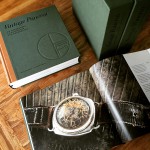 Aside several tools of his time as a “Gamma” frogman, Luigi Ferraro’s 3646 / Type B “Radiomir Panerai” never changed ownership and remained a memorable piece for him and his family since he returned from war. The watch shows intensive proof of aging and is an example of how different these rare watches have aged after more than 70 years. The watch still has its original strap, as well as its original domed plexiglas crystal – intensively aged with countless fissures. Numbers, indices and the typical “Radiomir Panerai” lettering on the riveted plastic dial can still be made out at some points.
Aside several tools of his time as a “Gamma” frogman, Luigi Ferraro’s 3646 / Type B “Radiomir Panerai” never changed ownership and remained a memorable piece for him and his family since he returned from war. The watch shows intensive proof of aging and is an example of how different these rare watches have aged after more than 70 years. The watch still has its original strap, as well as its original domed plexiglas crystal – intensively aged with countless fissures. Numbers, indices and the typical “Radiomir Panerai” lettering on the riveted plastic dial can still be made out at some points.
Luigi Ferraro’s watch has been recorded in our database in 2014, however the watch was known to us already years before. The Rolex 618 / Type 1 movement in combination with the small Oyster Watch Co hallmark, embossed on the inner caseback together with the reference and case number, is matching our criteria for being a watch of the Reference 3646 / Type B. The outer caseback bears a rare matriculation number, of which only a very few 3646 watches are known today. We have published further information about the different matriculation numbers on some of these watches in chapter II.III (page 301-303).
Luigi Ferraro’s 3646 / Type B “Radiomir Panerai” with riveted plastic dial is published extensively in chapter II.II (page 190-203) of the book “The References” 1930’s-1940’s.
More 3646 watches with an interesting history, related to their first owners and the missions they carried out during the Second World War, are introduced in chapter II.I (Ernesto Notari) and in chapter II.III (Licio Visintini). Enjoy reading!
25 July 1941 – today in history…
by Volker on Jul.25, 2025, under Allgemein
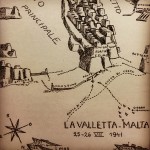 Augusta (Sicily) 11 pm. The night of 25 July 1941 marks the beginning of the “Operazione Malta 1”, known by its disastrous result for the Mezzi d’Assalto, only three months after the first successful attack with MT explosive boats against British ships in Souda Bay (Crete) on 26 March 1941. One day later, in the early morning of 26 July 1941, the Decima MAS lost the head of the flotilla (Capitano di Fregata Vittorio Moccagatta), the head of explosive boats (Capitano di Corvetta Giorgio Giobbe), the doctor of the flotilla (Tenente Medico Bruno Falcomatà), SLC pilots (including their inventor, Teseo Tesei) and MT explosive boats pilots during the attack of the harbour of La Valetta (Malta).
Augusta (Sicily) 11 pm. The night of 25 July 1941 marks the beginning of the “Operazione Malta 1”, known by its disastrous result for the Mezzi d’Assalto, only three months after the first successful attack with MT explosive boats against British ships in Souda Bay (Crete) on 26 March 1941. One day later, in the early morning of 26 July 1941, the Decima MAS lost the head of the flotilla (Capitano di Fregata Vittorio Moccagatta), the head of explosive boats (Capitano di Corvetta Giorgio Giobbe), the doctor of the flotilla (Tenente Medico Bruno Falcomatà), SLC pilots (including their inventor, Teseo Tesei) and MT explosive boats pilots during the attack of the harbour of La Valetta (Malta).
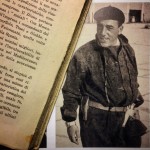 On a side note of the history, the commander of the explosive boats / “Mezzi di Superficie”, Giorgio Giobbe (1906-1941), is well known for wearing his Panerai watch on his right wrist in a photo taken prior the mission against Malta (see page 111-115 in chapter II.I). More about missions and watches of the Decima MAS can be found here.
On a side note of the history, the commander of the explosive boats / “Mezzi di Superficie”, Giorgio Giobbe (1906-1941), is well known for wearing his Panerai watch on his right wrist in a photo taken prior the mission against Malta (see page 111-115 in chapter II.I). More about missions and watches of the Decima MAS can be found here.
Read more about “The birth of a legend – the first Panerai watches (1935-1939)” in chapter I, followed by the timeline of the missions during the Second World War in chapter II.I – more information on the historic content in our “The References” book set can be found here. Read about the featured watches from Guido Panerai & Figlio in the first and second volume here.

